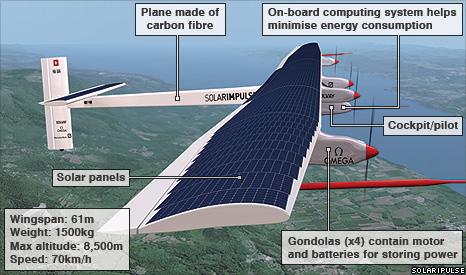Solar-powered plane lands safely after 26-hour flight
- Published
An experimental solar-powered aircraft launched on Wednesday has landed safely in Switzerland after successfully flying through the night.
The feat is a step toward the makers' aim of circling the globe using the power of the Sun to fuel the plane.
The aircraft used super-efficient solar cells and batteries to stay in the air after the Sun's rays had faded.
The plane touched down at an airfield about 30 miles (50 km) from the Swiss capital Bern at 0900 (0700 GMT).
The plane landed at Payerne airport after a total flight time of 26 hours.
During the flight it reached a height of 8,700 m (28,543 ft).
Assistants rushed to stabilise the experimental aircraft as it touched down, ensuring that its huge 63m (207ft) wingspan did not scrape the ground and topple the plane.
It is the longest and highest flight recorded by a solar-powered plane.
The four-engine aircraft was steered by Andre Borschberg, a former fighter jet pilot from Switzerland.
The plane has 12,000 solar cells arranged on its wingspan which collected enough energy to power the plane for the flight.
'Perpetual flight'
Previous flights of Solar Impulse have included a brief "flea hop" and a longer airborne test earlier this year. But this week's attempt was described as a "milestone" by the team.
The designers, the Solar Impulse team led by Mr Borschberg and fellow aviator Bertrand Piccard, say that this proves that a plane can be kept in the air around the clock.
"It's the first time ever that a [manned] solar airplane has flown through the night," Mr Piccard told journalists.
"That was the moment that proved the mission was successful, we made it."
The plane emerged from the darkness of night with three hours power remaining in its batteries, more than had been expected.
"Nothing can prevent us from another day and night, and the myth of perpetual flight."
The team will now build a new, more advanced, model of the plane.
They aim to circumnavigate the globe by 2013.

- Published7 July 2010
- Published1 July 2010